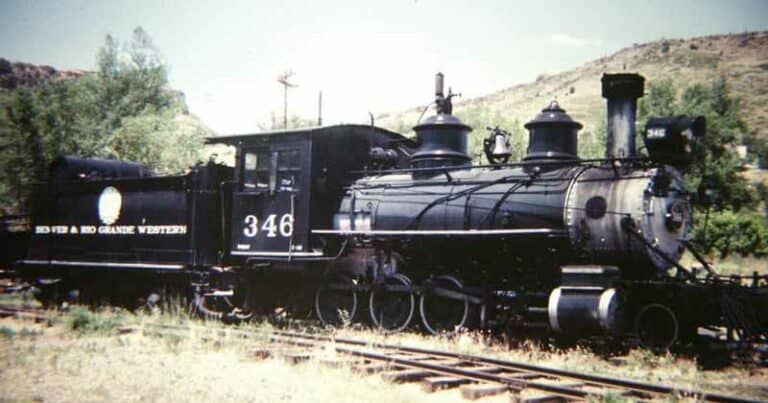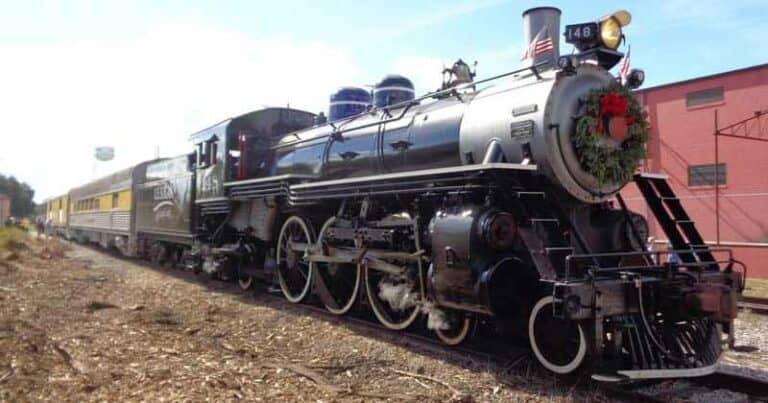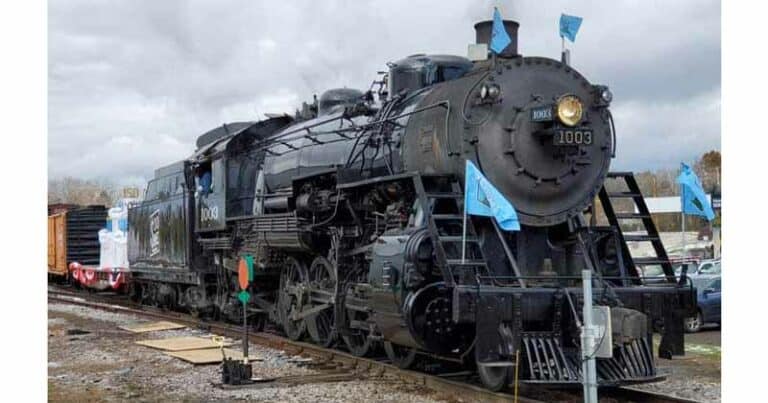The real Tweetsie Railroad, the ET&WNC
The East Tennessee & Western North Carolina Railroad
The East Tennessee and Western North Carolina Railroad began as a railroad, failed (more than once) as a railroad and now runs steam locomotives as a historic theme park that uses the railroad’s nickname, the Tweetsie. There just has to be a good story here!
Yes, there is. The East Tennessee and Western North Carolina Railroad (ET&WNC) was a 3 ft narrow gauge railroad that eventually ran 66 miles from Johnson City, Tennessee, to Cranberry, North Carolina and on to Boone, North Carolina. Construction began in 1866.

Narrow gauge was not unheard of in the East, but it was still unusual. Narrow gauge railroads could save money on construction and could more easily navigate mountainous or rugged terrain. It was often mining companies that went with narrow gauge – and that was the case here too.
The first backers of the railroad hoped to reach the iron mines at Cranberry, North Carolina from Johnson City in Tennessee where they could bring the iron (and timber) of western North Carolina back to connections with the Southern Railway and the Carolina, Clinchfield and Ohio Railway (later known as the Clinchfield Railroad).

A mid-1890s survey done of the Cranberry Magnetite Iron Ore Belt gave a conservative estimate of 5-million tons of iron ore that could be easily reached. This would be by far the largest vein of ore in the southeast. A railroad was needed to get this ore to mills.
Track was laid to about halfway to Cranberry, but in 1874 the money ran out and the railroad failed. Failure number one. However, by 1879, the owner of the iron mines, the Cranberry Iron Company realized the railroad guys had been on to something. They acquired the assets and started to lay track again. The ET&WNC reached the mines in 1882.
The financial backing of the mining company and engineering by noted railway engineer Thomas Matson meant a well built line. A continuing supply of iron ore and timber meant a profitable railroad. The next 50 years were good ones for the railroad. During that time the line was extended to Boone, North Carolina by purchasing the Linville River Railway.

The railroad has a couple of nicknames. The “Tweetsie” came from its initials: ET&WNC. Since Eastern Tennessee & Western North Carolina is quite the mouthful, locals just smashed up the initials into “Tweetsie”. It is of course the nickname that has survived as the name of the nearby heritage railroad and amusement park.
From the beginning the railroad had another nickname from residents of the small mountain towns. Stories are that railroad personnel would help with errands and during the depression allowed down-on-their-luck residents free passage on ET&WNC passenger trains. The nickname? “The Railroad with a heart.” The railroad enjoyed this nickname and even punched tickets with a heart-shaped hole punch.

The iron mines and railroads made it through the depression, but a flood in 1940 closed the Linville River Railway line. World War 2 saw an increase of traffic, but that traffic faded quickly after the war. The passenger business dried up and the freight business was concentrated at the Tennessee end of the line.
In fact, the 11 miles between the interchanges with larger railroads at Johnson City and industries at Elizabethton were made dual gauge, both standard and narrow gauge to make switching easier. The ET&WNC purchased three used standard gauge locomotives to operate these 11 miles and continued to operate the entire line, dual gauge and narrow gauge. See the story of two of those standard gauge steam locomotives below.
After Johnson City and Elizabethton went dual gauge, things went down hill quickly for everything east of Elizabethton. The narrow gauge only lines ended all operations in October of 1950. The rails were scrapped the following year, making sure trains would not run through this part of the Blue Ridge again.

That’s failure #2 for the railroad. In 1952, all narrow gauge steam locomotive were put up for sale. Even though the the ET&WNC offered to donate numbers 9 and 11, there were no takers and the two were scrapped. #12 was saved by…movie cowboy Gene Autry to use in his films. That did not work out for Autry, but #12 became a star anyway!
Interestingly – and unintentionally – the ET&WNC had a hand in saving two very famous steam standard gauge locomotives. What we know today as Tennessee Valley Railroad Museum #630 was ET&WNC 207 and ET&WNC 208 is now Great Smoky Mountains Railroad #722.
Eventually the ET&WNC dieselized, bringing on two used ALCO RS-3 diesels from Southern Railway in 1967. This is, by the way, how the two steam locomotives mentioned above were saved to be restored and run today. They were traded for the diesels. They become the “newest” steam locomotives owned by the Southern Railway and so became part of the Southern’s later public relations steam program.

The diesels continued to power the now much-truncated ET&WNC. Primary traffic for the last 11 mile segment was industry in Johnson City, including chemicals, and large rayon plants in Elizabethton. Finally in 1983, even that 11 miles was too much. The third failure for those counting.

The Green Bay Packaging Company acquired the assets of the ET&WNC and formed the East Tennessee Railway (ETRY). The ET&WNC name was officially gone.
In 2000 the last rayon plant closed after a huge fire. Tracks were no longer need to Elizabethton. Tracks were taken up between Johnson City and Elizabethton. In 2003 operations were cut back further and more tracks were taken up. A popular rail trail has been put down in place of the railroad.
In 2005 international shortline operator Genesee & Wyoming acquired the East Tennessee Railway and more track was cut. From 2015 through today what was the ET&WNC operates seven miles of track centered around and in the Johnson City Yard. Success or Failure? Certainly an ignominious end to a great railroad.
What is a an unqualified success is the proud legacy of the Eastern Tennessee & Western North Carolina Railroad. The Tweetsie Railroad heritage railroad and theme park keeps the ET&WNC story – and steam locomotive #12 – alive. The Tweetsie Trail is a popular walking trail between Johnson City and Elizabethton in Tennessee. And the railroad had a hand in saving Tennessee Valley Railroad Museum 630 and Great Smoky Mountains Railroad 722.

Railfan and model railroader. Writer and consumer of railroad news and information.







